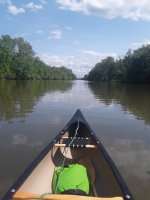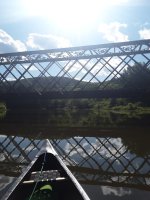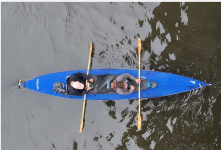Just about all tandem canoes have the stern seat much closer to the back end of the canoe than the bow seat is to the front end. Why?
The canoe designer presumably has spent a lot of time designing an optimized waterline shape that assumes a level trimmed canoe. Yet, when two equal weight paddlers sit on standard tandem canoe seats, the canoe immediately goes bow light, thereby distorting the design waterline.
Worse, it is overwhelmingly common for the heavier paddler to sit in the stern, such as a man in the stern and a woman in the bow or an adult in the stern and a child in the bow. In these situations where the heavier paddler is in the stern, the canoe will be significantly out of trim and the bow might even rise out of the water, thereby creating some sort of Frankenstein waterline shape that probably never appeared on the designer's drafting table or computer program.
What are the design, performance, efficiency or practical reasons for the stern and bow seats to be placed at asymmetrical distances from the ends of the canoe? Wouldn't there be more trim equality and flexibility if the seats were placed at some equal distance from the ends?
The canoe designer presumably has spent a lot of time designing an optimized waterline shape that assumes a level trimmed canoe. Yet, when two equal weight paddlers sit on standard tandem canoe seats, the canoe immediately goes bow light, thereby distorting the design waterline.
Worse, it is overwhelmingly common for the heavier paddler to sit in the stern, such as a man in the stern and a woman in the bow or an adult in the stern and a child in the bow. In these situations where the heavier paddler is in the stern, the canoe will be significantly out of trim and the bow might even rise out of the water, thereby creating some sort of Frankenstein waterline shape that probably never appeared on the designer's drafting table or computer program.
What are the design, performance, efficiency or practical reasons for the stern and bow seats to be placed at asymmetrical distances from the ends of the canoe? Wouldn't there be more trim equality and flexibility if the seats were placed at some equal distance from the ends?




